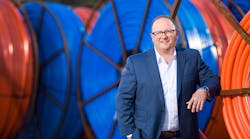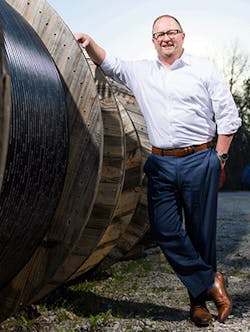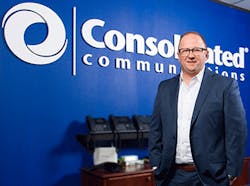Learn about Consolidated’s network priorities, FTTX deployments, and cultural transformation priorities.
Topic: Priorities
ISE: What are 2 of Consolidated’s top network-related priorities in 2021?
Waggoner: Our mission is to turn technology into solutions and to enrich how people work and live. Today, we have operations centered around 5 core regions across the US, and a robust, fiber-centric 100G network that, I’m pleased to say, has stood up very well to the demands and increased utilization we’ve seen over the past 14 months.
Last year, we announced an ambitious network expansion to build out fiber-to-the-home (FTTH)
to over 1.6 million passings over a 5-year period. We’ll start by upgrading more than 300,000 locations in 2021 with synchronous multi-gig speeds. This is a transformational initiative and the largest network expansion in our company’s history. When complete, over 70% of our footprint will be fiber-capable. The expansion will help future-proof our business and create lasting economic development, e-commerce, and quality-of-life benefits and opportunities, within the communities we serve.
We’re also expecting network utilization to continue trending higher in 2021, so we’re continuing to enhance and strengthen our 100G mesh core network.
Additionally, we’re in the midst of a large-scale digital transformation initiative that will improve customer support channels with increased functionality, simplicity, and automation. This is an exciting time for our company.
Topic: 5G — It’s All About Fiber
5G will not only enable transformative new services (e.g., the Internet of Things, connected cars, telehealth, and precision agriculture) it will create economic productivity and jobs.
But the future of wireless is inextricably linked to our ability to deploy fiber infrastructure across the country. If we want to bring economic productivity and jobs, we need to scale fiber and deploy more fiber — to everyone.
ISE: What are some creative solutions Consolidated is employing to help FTTx-to-Everywhere efforts?
Waggoner: It’s true, there are many emerging technologies 5G will enable; however, to truly realize the promise of 5G, once again, fiber is essential.
The high cost of building in some rural areas is a challenge but Consolidated has been innovative in finding ways to get more people connected. For example, in the last 2 years, we’ve had success with public-private partnerships using municipal bonds that make building out broadband infrastructure economical. These builds deliver fiber-to-the-home or to-the-business in rural communities, without increasing taxes, and are a cost-effective, mutually beneficial solution.
In addition to public-private partnerships and our strategic build plan, we are also leveraging the opportunities presented by federal and state rural broadband initiatives, including RDOF and CARES Act programs. Using RDOF locations as a starting point, we’ll invest in fiber in more rural locations than originally planned.
In locations where deploying FTTH may not make economic sense, we’re using our fiber to light up fixed wireless services as well.
This continued outside-the-box thinking allows us to further expand our fiber network to more locations — and we are excited to get more people connected and to help transform local communities.
InvisiLight® Solution for Deploying Fiber
April 2, 2022Go to Market Faster. Speed up Network Deployment
April 2, 2022Episode 10: Fiber Optic Closure Specs Explained…
April 1, 2022Food for Thought from Our 2022 ICT Visionaries
April 1, 2022Topic: NetDev Ops and Edge Computing
5G requires edge computing, which brings content or data processing capability closer to the end user or data source so that an instantaneous, real-time response can be delivered.
Virtualization makes this possible, and virtualization is a practice which sits in the domain of DevOps. By adopting Cloud native architecture, telcos can move services towards the edge of the network to provide the required latency and throughput.
ISE: Share your thoughts about this and Consolidated’s road map in this area.
Waggoner: Edge computing and virtualization can mean a lot of things to different people. Our perspective at Consolidated is this: for any distributed application that is latency sensitive, fiber-based broadband is needed to enable it.
Our approach has been to continue focusing our product development on our IP broadband service solutions, including hosted voice, and also frequently used applications like data protect, Cloud Wi-Fi, and SD-WAN, when appropriate. We also offer space or server capacity in our data centers, when packaged with network access services, and have a solutions-based approach that allows us to ask the right questions to understand what the data networking and performance objectives are for your business. This helps us assemble our service building blocks to meet your needs.
Topic: In Pursuit of Knowledge
ISE: What’s the best book you’ve read this year?
Waggoner: Diversity, inclusion, oppression, and marginalization, are all themes that have never been more prevalent in our everyday dialogue. I recently finished Caste: The Origins of Our Discontents by Isabel Wilkerson, and it was a challenging but insightful read that provided me with some incredibly thought-provoking perspectives to reflect on.
Topic: RDOF
In early January, 2021, the Federal Communications Commission announced its new Rural Digital Opportunity Fund (RDOF) for faster broadband speeds to help close the Digital Divide in rural areas.
Over the next 10 years, RDOF will push out up to $20.4 billion in funding to build and connect gigabit broadband speeds in unserved rural areas.
ISE: What are the best network deployment strategies providers should embrace to deliver on their commitment after receiving these funds?
Waggoner: Consolidated’s RDOF funding coupled with a recent strategic investment and partnership will significantly accelerate fiber expansion to rural areas across our service area. Combined, we will upgrade 1.6 million passings to fiber, multi-gigabit services over a 5-year period.
The RDOF auction also served as a catalyst for us to perform a more comprehensive market analysis, and examine our network and its proximity to resources and densities in order to maximize our investments and add more passings. This strategy allows us to connect more consumers and small businesses in areas not funded by RDOF.
We continue to leverage our existing network to maximize value creation and serve as many customers as possible. This includes areas where we didn’t participate in the formal program, but still see the opportunity to build to more locations based on proximity to network and attractive cost-per-passing.
Topic: COVID-19 — A Year+ Later
ISE: If necessity is the mother of invention, what new, successful things are you doing now that have been born from the learning you’ve acquired over the last year?
Waggoner: We take our role as a critical infrastructure provider very seriously, and our initial primary focus at the onset of the pandemic was maintaining business continuity while keeping our employees safe.
Last year, we established a successful work-from-home structure by taking aggressive, proactive measures to transition 90% of our employees to remote work. It required a herculean effort from our teams, but it was, and still is, very successful.
Remote work is part of our long-term business strategy around the future work environment and has expanded to also include new employee recruitment and virtual onboarding. In particular, we’ve developed robust remote training programs for our call centers with new software solutions that make remote training and remote work more practical than ever.
We also increased self-serve options within our online customer portal and IVR to provide a better omnichannel experience and to make it easier for customers to reach us. Interactive text functionality for technician appointments was also deployed, which not only reduced no-access dispatches, but also gave our customers another way to easily notify us if a last-minute safety-related concern surfaced at their location.
In addition, we enhanced CPE shipping options to minimize the need for in-person retail center visits and to provide additional ship-from-home conveniences for our customers.
The intense focus on universal broadband access is ongoing, with more momentum behind it than ever before. The challenge and newly available funding opportunities really pushed our team to further develop creative models and approaches to accelerating our fiber deployments.
Topic: Connecting the Underserved for Remote Learning
According to a recent survey conducted by Digital Wish, 19% of students do not have Internet connectivity at home, and over 21% do not have access to a computing device, impacting their ability to adequately participate in remote learning. (Source: https://www.digitalwish.com/dw/digitalwish/home)
ISE: Share what new "tools in the toolbox" Consolidated is using to reach/connect the underserved?
Waggoner: Consolidated is actively working to expand broadband in rural, underserved communities as evidenced by our aggressive fiber expansion and the innovative ways we’re partnering with cities and towns to get more individuals, families, and businesses, connected. We also work hard to help customers find low-cost options, like the federal and state-run Lifeline programs to address economically disadvantaged households. And, of course, it goes beyond Internet access.
We recently launched a new technology-focused educational grant program, Consolidated Connects, supporting K-12 schools and helping to address remote learning gaps with its inaugural funding cycle.
Moving forward, we’ll continue to evaluate alternative technologies and partnerships for creative solutions to serve more rural customers, including the extension of our fixed wireless solutions. With 5G, where we place emphasis on expanding wireless backhaul and maximizing fiber-centric tower connectivity solutions across multiple states, we see new opportunities to continue leveraging and extending our network across our footprint.
Topic: Cost Efficiencies
In the current economic environment, conservative cash management is imperative.
ISE: How has your team created cost efficiencies? Please elaborate.
• Over the past year, we’ve deployed automated interactive text notification for technician appointments, which reduced no-access truck rolls.
• New home shipping and e-Commerce advancements allowed us to decommission retail centers this year, lowering overhead costs.
Overall, our Cloud-based call management, dispatch and operations support system (OSS) platforms are flexible enough to allow over 90% of our employees to work remotely. Not only do they provide excellent continuity, but we’re now able to consider a permanent remote workplace for many teams. As such, we’re looking at a smaller office footprint and the sale of real estate assets we may no longer need, which will generate significant savings for our company.
Our ongoing Digital Transformation Initiative to improve self-serve web portal functionality, implement voice analytics using AI and deliver an improved overall omnichannel experience, is also creating numerous efficiencies. It includes integrating robotic process automation (RPA) solutions to enhance the agent-user-interface and to add automation to the service delivery stack.
When customers utilize our online self-care tools or manage their account via IVR automation, without needing to speak with a representative, our customer care employees are able to more easily manage increased workloads without supplemental resources. It also provides additional time to address other calls or customer needs in their queue.
Topic: Overlooked Issues
ISE: What should all of us in the Information and Communication Technology industry be talking about that we are not? Or what current topic is the most important that needs additional and different attention?
Waggoner: In a word, simplification. Ensuring technology makes sense for our customers and,
perhaps more importantly, making it easier for them to do business with us when in need of
specific services, is essential.
This year, guided by our important Digital Transformation Initiative, we are implementing a number of enhancements and conveniences for our customers — consumer, commercial, and carrier. Our goal is simple: make it easier, faster, and more enjoyable, for them to do business with us. The changes make us nimbler when operational improvements are needed, and help us to grow and retain revenue as well.
The breadth and depth of communications solutions keeps growing, and we need customers’ assurance they can access and consume these solutions quickly and easily.
Topic: Cultural Transformation
ISE: Explain why cultural transformation is equally important as technical transformation to ensure Communications Service Providers thrive in the future.
Waggoner: Never has there been a more exciting time to be part of this industry, but only if you truly embrace change. Technological transformations are giving us rapid advancements in Cloud, IoT, 5G, AI, RPA, SDN, and countless other amazing solutions. We must create a culture where we see new technology in this same positive light and view it as an opportunity and not with apprehension or fear of obsolescence.
Our industry is unique. With companies like ours that have been in business for over 125 years, we are steeped in history yet have an opportunity to be at the forefront of exciting technological change. We don’t want our teams to lose their pride of heritage, but a culture that clings too tightly to conventional wisdom and traditional processes won’t be able to lead the technological transformation we’re in today. It’s essential for leaders to effectively articulate this in a manner that recognizes history and values yet provides a clear vision for the future. At our core, we may be a progressive broadband technology solutions provider, but we must instill a culture that embraces creativity, agility, and change.
Topic: Pain Points
ISE: What are Consolidated’s biggest network-related challenges right now?
Waggoner: As a network infrastructure provider, we’re tasked with keeping our internal networks safe so our business is secure while at the same time ensuring our customers are safe on our nationwide network.
We’ve seen a significant increase in cyberattacks all over the world, and as our head of network security always say: People are the biggest risk. With more people working and learning remotely, the number of intrusion points has increased exponentially. VPN attacks, DDoS attacks, phishing, vishing — vigilance is critical. We’ve taken significant steps to further enhance our security practices, including major employee and customer education efforts.
Our network security teams are aggressive and proactive, running both offensive and defensive security measures. They test constantly and have extensive network monitoring that alerts them to unexpected user behaviors. Network security is always a challenge, but it’s one that is always in the forefront of our minds.
Topic: Supply Chain
ISE: In what ways has Consolidated been challenged by supply chain issues? Are there suggestions you have for the vendor community to help remedy these challenges?
Waggoner: In our industry, efficiency is key, and maintaining a lean inventory has been a tried-and-true practice. However, we are aware of the extended lead times for various supplies and equipment. Moving forward, companies may need to reevaluate traditional inventory assumptions and take a longer view for the foreseeable future.
While we keep the effects of the pandemic in mind, the planning and ongoing collaboration with our many long-time vendors and suppliers around our strategic network expansion has allowed us to remain ahead of the curve. Having a fully funded and highly detailed build plan in place to carry us through the next 5 years means we’re acutely aware of our needs, and of any challenges we may face, well ahead of time.
We’re also having conversations with our vendors about diversification of their own suppliers, determining effective surplus levels and ensuring access to data and information to identify important trends in their markets. Keeping the lines of communication open with our partners is mutually beneficial and ensures needs can be met on both sides.
Topic: Wishes
ISE: What is one decision you wish you didn’t make? Or which one thing do you wish you’d done differently?
Despite these existing reservations, we initiated an extensive work-from-home strategy very early in the pandemic, which proved to be extremely successful. I was pleasantly surprised to find employee productivity remained high and even improved in many instances. We generated numerous unexpected and unanticipated efficiencies, and I’m proud of our team’s success and understand we may have had an earlier opportunity.
Employee satisfaction also improved in a number of areas, something we are continuing to build on this year through various employee engagement programs and key initiatives. The importance of enhancing employees’ quality of work-life and their passion for service excellence and brand ambassadorship cannot be overstated.
With a workforce that is now more largely distributed, we want to keep our teams engaged and connected to one another, to leadership, and to our business. When our employees feel heard and valued, they will thrive — and our company will thrive.
Topic: Failure
ISE: What happens at Consolidated when people fail?
(Question source: Bob Sutton and Jeff Pfeffer, Stanford professors via https://www.inc.com/.)
Waggoner: We have an incredibly talented group of people at Consolidated with tremendous experience, so it goes without saying that there is a great deal of pride in "getting it right" the first time. On those occasions where we do miss the mark, our teams have a greater sense of pride in doing whatever it takes to make it right, especially with our customers.
Failure is an opportunity to learn. Our culture is one that embraces the learning process and provides a safe and supportive place to truly own failure. We value honesty, transparency, and accountability with one another, and with our customers, and when we trip up, we look to the opportunities that come along with improvement.
Biography
Gabe Waggoner is the Executive Vice President of Operations at Consolidated Communications, with responsibility for field operations, network operations, customer service and overall service delivery strategy for the Company. Prior to his current role, Waggoner served as Director of Network Services. He joined the Company in 1996 and has a diversified background, having served in numerous management and leadership roles in customer service, construction management, engineering and field services. Waggoner earned his master’s degree in business administration and his bachelor’s degree from the Lumpkin School of Business at Eastern Illinois University.
For more information, visit https://www.consolidated.com/.












